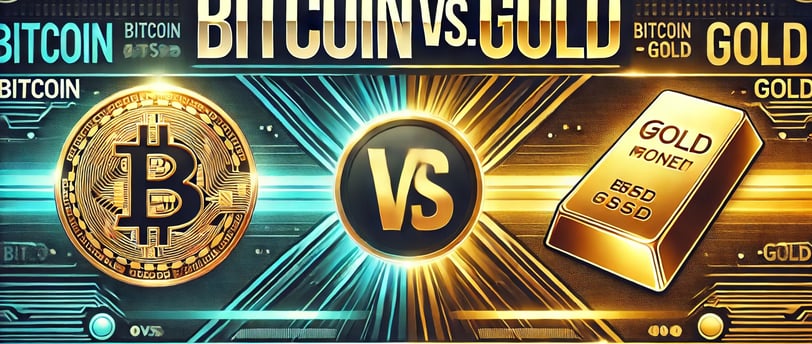Gold vs. Bitcoin: A Hard Money Showdown in 2024
Gold and Bitcoin are both nearing record highs, sparking a debate over which is better hard money. Explore their roles as safe havens, inflation hedges, and how they might perform in 2025 amidst economic uncertainty.
10/30/20243 min read


Gold vs. Bitcoin: A Hard Money Showdown in 2024
Disclosure: This article is for educational purposes only and does not constitute investment advice.
With both gold and Bitcoin trading near record highs, the debate over which is the superior “hard money” is intensifying. As economic uncertainty, inflation, and geopolitical changes persist, investors are increasingly drawn to these two assets as defensive hedges. But which one truly holds its ground as the ultimate safe haven?
📈 Take a Crypto Trade? Use one of These Offers!
❎ BITFLEX: Double your first deposit up to 100%! Get a bonus of up to $2,000 with this referral link: https://bit.ly/4d0k9i3.
🟧 BYBIT: New users depositing over $100 can earn up to 6,045 USDT in signup bonuses. Start trading here: https://bit.ly/3MgHQaZ.
🚀 Alpha One Signals: Take my 90% Binary Options Signals: http://alphaonesignals.com/
The Rise of Gold and Bitcoin in 2024
As of October 2024, gold has surged past $2,770, while Bitcoin is nearing its all-time high of $73,800. Both assets have outperformed most traditional investments this year, reflecting heightened anxiety over economic stability.
Gold has risen by 38%, driven by traditional investors seeking stability, while Bitcoin has surged by 115%, buoyed by younger, tech-savvy investors who view it as “digital gold.”
What Makes Gold “Hard Money”?
Gold’s status as a safe-haven asset is rooted in centuries of history. It is tangible, has intrinsic value, and is recognized globally as a store of wealth. Its value is backed by physical constraints—new supply is limited to mining capabilities, ensuring scarcity.
Gold is favored for its stability during periods of crisis, as seen during the 1970s inflationary era and the 2008 financial crisis. It remains a preferred choice for conservative investors who value its lack of volatility compared to digital assets.
Peter Schiff, a vocal gold advocate, recently noted:
“Gold’s peak is just beginning, unlike in 1979 when inflation was peaking. Now, inflation is likely near its trough, indicating gold’s bull market has only just started.”
Bitcoin: Digital Gold or Risky Bet?
While Bitcoin lacks the centuries-old track record of gold, its appeal as “digital gold” has grown significantly over the last decade. With a finite supply of 21 million coins, Bitcoin’s scarcity is enforced by code, making it a deflationary asset.
Unlike gold, Bitcoin offers greater portability, ease of transfer, and decentralized security through blockchain technology. Despite its volatility, Bitcoin’s programmed scarcity and halvings (reductions in mining rewards every four years) contribute to its deflationary potential, similar to gold’s limited mining output.
Chamath Palihapitiya, a tech billionaire, recently claimed:
“Bitcoin is the inflation hedge of the next 50 to 100 years, effectively replacing gold as a rational economic insurance policy.”
Are Surging Prices a Warning Sign?
The concurrent rise in gold and Bitcoin may be more than just individual rallies—it could signal growing concerns about the broader economy. Historically, significant gains in these assets have preceded downturns, suggesting that today’s price movements might reflect a broader lack of confidence in traditional financial markets.
1970s Inflation: Both gold and other hard assets soared as inflation skyrocketed.
2008 Financial Crisis: A flight to safety saw gold prices rise sharply, while Bitcoin emerged shortly afterward as a digital alternative.
Recent studies also underscore their roles as hedges. Bouri et al. (2017) found that Bitcoin functions as a hedge similar to gold, especially during currency devaluation and macroeconomic uncertainty.
Head-to-Head: Gold vs. Bitcoin in 2025
As we head into 2025, the hard money debate remains unresolved, but the differences between gold and Bitcoin are clear:
Historical Stability vs. Innovation:
Gold is backed by centuries of stability.
Bitcoin represents a digital alternative, designed for the tech-driven 21st century.
Physical vs. Digital Scarcity:
Gold’s value is limited by mining capacity.
Bitcoin’s supply is hard-capped at 21 million, with halving events adding to its scarcity appeal.
Portability & Accessibility:
Gold requires physical storage and logistics.
Bitcoin can be stored on a hardware wallet and transferred globally within minutes.
Inflation Hedge Potential:
Both gold and Bitcoin have been viewed as hedges against inflation, but Bitcoin’s younger demographic and technological edge make it more appealing to millennials and Gen Z.
What Should Investors Consider?
Both gold and Bitcoin are likely to remain popular as hedges, but choosing between them depends on individual risk tolerance, investment horizon, and perspective on digital vs. traditional assets.
Gold: Ideal for those seeking long-term stability, tangible value, and historical safety.
Bitcoin: Suited for investors willing to embrace volatility, digital innovation, and rapid growth potential.
Conclusion: A Hard Money Showdown for Uncertain Times
In uncertain times, both gold and Bitcoin offer viable paths to preserving wealth. While gold remains the established choice, Bitcoin's rising popularity as a digital alternative cannot be ignored. The debate over which asset will prevail as the ultimate hard money is likely to continue, especially as we head into 2025 with potential economic shifts on the horizon.
For now, both assets serve as crucial indicators of market sentiment—each with its own merits and risks. Whether you prefer the tangible feel of gold or the digital promise of Bitcoin, the choice ultimately boils down to how you perceive risk, value, and the future of money itself.
